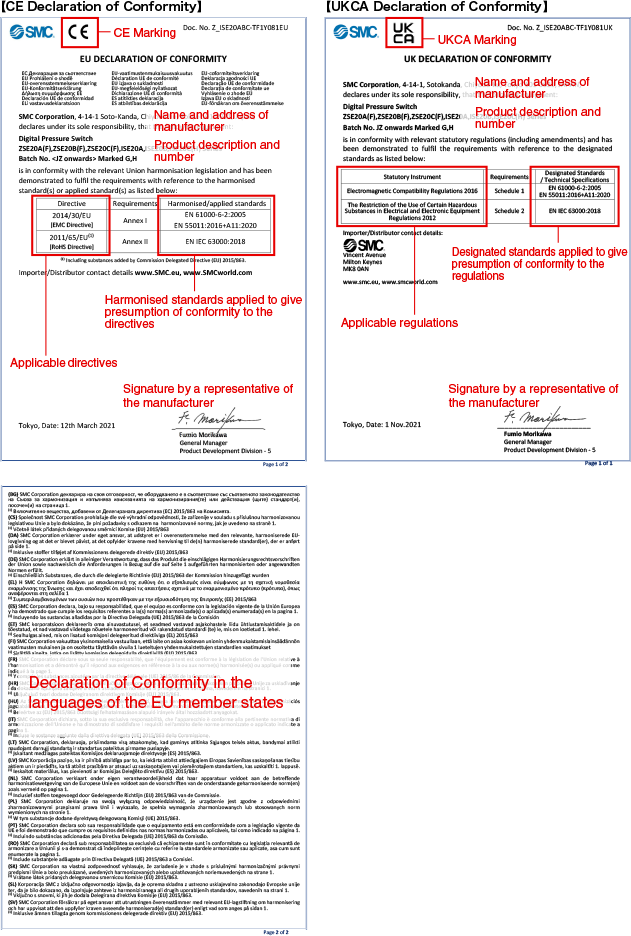
“CE”came originally from the French“Communauté Européenne” (the European Community,
predecessor of the European Union) and now stands for “Conformité Européenne“ (European Conformity).
The CE marking signifies that the product is assessed to meet all essential requirements of applicable EU legislation when it is placed on the EU market.
All products subject to certain EU directives must conform to the requirements of the directives in order be placed on the EU market.
By preparing a Declaration of Conformity and affixing the CE marking, which is usually a “self-certification” process, the manufacturer declares that their product is in compliance with applicable legislation. Without the CE marking, distribution of the product on the European market is not allowed.
The CE marking is required in the EU member states and the European Free Trade Association (EFTA) member countries - Norway, Iceland, Liechtenstein, and Switzerland. It is also required in Turkey, which is not a member to either the EU or the EFTA (as of August 2021).

The UKCA (UK Conformity Assessed) marking is a new UK product marking that is used for goods being placed on the market in Great Britain (England, Wales and Scotland). It covers goods which previously required the CE marking.
All products in scope of UK regulations must conform to the relevant statutory requirements. The manufacturer must prepare a Declaration of Conformity and affix the UKCA marking to the product, in order to place it on the market in Great Britain. Without the UKCA marking, distribution of the product on the GB market is not allowed.
|Products subject to CE & UKCA marking
Electrical and electronic equipment, industrial machinery, explosive atmosphere devices, pressure equipment, etc.
|Legislation
Legislation is published to allow free movement of goods on the market. The legislation is satisfied by complying with relevant standards.
Some products are subject to more than one EU directive or UK regulation.
Note that the EU market is a separate market to the GB market and placing on one market has no relevance to placing on the other. Movements of goods from one to the other is subject to import/export rules.
Pneumatic products containing electric or electronic parts fall in the scope of the EMC Directive/Regulations or the Low Voltage Directive/Regulations, or both as well as the RoHS Directive/Regulations.
Affixing the CE marking indicates that the product complies with all applicable EU directives (EU market).
Affixing the UKCA marking indicates that the product complies with all applicable UK regulations (GB market).
The harmonized standards applied to give presumption of conformity are European standards (EN).
The below list shows main EU and UK legislation relevant to SMC products:
1.Low Voltage
The voltage legislation applies to equipment operating with rated voltage between 50 and 1000 VAC or between 75 and 1500 VDC, to ensure electrical safety of electrical and electronic components.
2. Electromagnetic Compatibility
The electromagnetic compatibility legislation applies to electrical and electronic equipment. The legislation requires to minimize electromagnetic radiation adversely affecting other equipment (emission) and to be able to resist the electromagnetic radiation from other equipment (immunity).
3.Machinery
The machinery legislation applies to industrial machinery, primarily machine tools, injection molding machines and automated machines. Components that provide a safety function are also covered by this legislation.
4.Simple Pressure Vessel
The simple pressure vessel legislation applies to simple pressure vessels manufactured in a series. A 'simple pressure vessel' means any welded vessel made of carbon steel or aluminum, designed to contain an internal pressure greater than 0.5 bar that is air or nitrogen, and not intended to be fired. The maximum working pressure of the vessel can't exceed 30 bar and the product of the working pressure (PS) and the capacity of the vessel (V) shall not exceed 10,000 bar?L. Only pressure vessels for which the product of PS × V is 50 bar?L fall in the scope of the simple pressure vessel legislation and are subject to a type examination.
5.Pressure Equipment
The pressure equipment legislation applies to pressure equipment with a maximum allowable pressure greater than 0.5 bar, including vessels, piping, and large-scale filters.
The legislation also applies to cylinders intended to be used as air tanks. The equipment is classified into categories by fluid, internal capacity and port size. Some categories are subject to a type examination.
Click here for relevant products in the 'SEP category'.
*What is a SEP category,
Pressure equipment classified below Category I and not subject to a Category I, II, III or IV
conformity assessment, but which must be designed and manufactured in accordance
with ‘Sound Engineering Practice’.
Products in the SEP category cannot be labelled with the CE/UKCA mark.
6.Explosive Atmospheres
The explosive atmospheres legislation applies to equipment intended for use in potentially explosive atmospheres. It also applies to pneumatic products which have a source of ignition as a result of friction, impact, electrostatic charge or wear. Specific explosive atmosphere marking as well as CE or UKCA marking must be shown on the product label and declaration of conformity. Visit our ATEX Legislation page for more details.

7.RoHS
The RoHS legislation applies to electrical and electronic equipment with regards to the restriction of the use of hazardous substances. Non-electrical products such as fittings are out of scope of RoHS legislation. EU and UK customers may require the RoHS compliant non-electrical products if such products are to be part of other electrical and electronic equipment. SMC can supply RoHS compliant non-electrical products upon request. Visit our RoHS Legislation page for more details.

8.Radio Equipment
The radio equipment legislation applies to devices having radio communication functions such as SMC wireless systems. ‘Radio equipment’ means an electrical or electronic product, which intentionally emits and/or receives radio waves for the purpose of radio communication and/or radiodetermination, or an electrical or electronic product which must be completed with an accessory, such as antenna, so as to intentionally emit and/or receive radio waves for the purpose of radio communication and/or radiodetermination.
|CE & UKCA Marking and Declaration of Conformity
The CE and UKCA marking means that the manufacture declares under its sole responsibility, that the product conforms to the requirements of the relevant legislation. SMC declares conformity of the product to the applicable EU directives and UK regulations, referencing the standards applied to fulfil the requirements and ensuring safety of the product.
For some products, SMC may declare conformity based on the certificate issued by an EU notified body or UK approved body which examined the product according to the relevant standards to fulfil the requirements of the applicable EU directives or UK regulations.
Example: Z/ISE20 Series Declaration of Conformity





